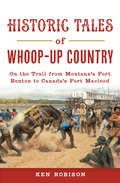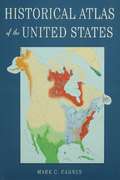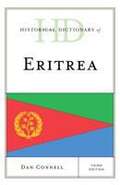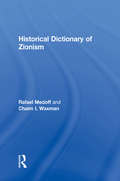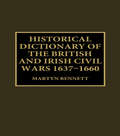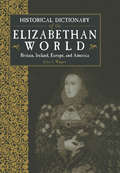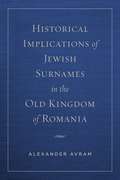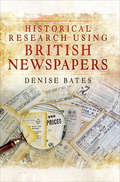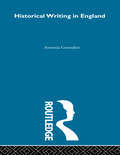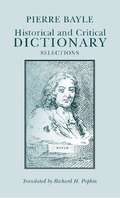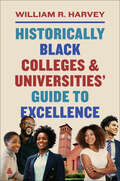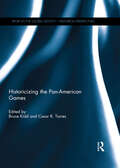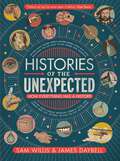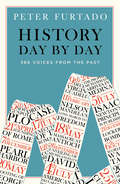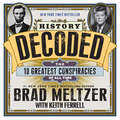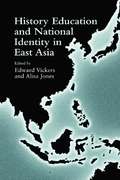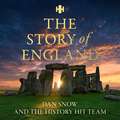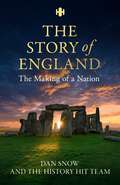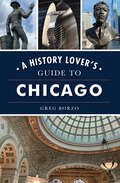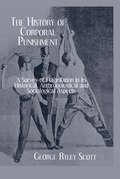- Table View
- List View
Historic Tales of Whoop-Up Country: On the Trail from Montana's Fort Benton to Canada's Fort Macleod (Lost)
by Ken RobisonWithdrawal of the mighty Hudson Bay Company from present-day Alberta and Saskatchewan created a lawless environment with new economic opportunities. A cross-border trading bond arose with growing steamboat mercantile center Fort Benton in Montana Territory. In 1870, Montana traders Johnny Healy and Al Hamilton moved across the Medicine Line and built Fort Whoop-Up. It established the two-hundred-mile Whoop-Up Trail from Fort Benton, through Blackfoot lands, to the Belly River near today's Lethbridge. Over the next decade, the buffalo robe trade flourished with the Blackfoot, as did violence. The turmoil forced the creation of Canada's North West Mounted Police, tasked with closing down the whiskey trade and evicting the Montana traders. Award-winning historian Ken Robison brings to life this dramatic story.
Historical Atlas of Northeast Asia, 1590-2010: Korea, Manchuria, Mongolia, Eastern Siberia
by Robert Cribb Narangoa LiFour hundred years ago, indigenous peoples occupied the vast region that today encompasses Korea, Manchuria, the Mongolian Plateau, and Eastern Siberia. Over time, these populations struggled to maintain autonomy as Russia, China, and Japan sought hegemony over the region. Especially from the turn of the twentieth century onward, indigenous peoples pursued self-determination in a number of ways, and new states, many of them now largely forgotten, rose and fell as great power imperialism, indigenous nationalism, and modern ideologies competed for dominance.This atlas tracks the political configuration of Northeast Asia in ten-year segments from 1590 to 1890, in five-year segments from 1890 to 1960, and in ten-year segments from 1960 to 2010, delineating the distinct history and importance of the region. The text follows the rise and fall of the Qing dynasty in China, founded by the semi-nomadic Manchus; the Russian colonization of Siberia; the growth of Japanese influence; the movements of peoples, armies, and borders; and political, social, and economic developments—reflecting the turbulence of the land that was once the world's "cradle of conflict." Compiled from detailed research in English, Chinese, Japanese, French, Dutch, German, Mongolian, and Russian sources, the Historical Atlas of Northeast Asia incorporates information made public with the fall of the Soviet Union and includes fifty-five specially drawn maps, as well as twenty historical maps contrasting local and outsider perspectives. Four introductory maps survey the region's diverse topography, climate, vegetation, and ethnicity.
Historical Atlas of the United States
by Mark C. CarnesDesigned for all libraries, this large-format, full-color atlas is an authoritative guide to the history of the United States. From the formation of the continent up through current events and information based on the most recent census, this work uses the geography of the United States to portray the history of the land and its people. The 300-plus maps tell the engaging story of America with detailed, clear information; accompanying text highlights key information presented in each map. An indispensable tool for students and educators alike, the Historical Atlas of the United States is destined to become a classic in the field.
Historical Dictionary of Eritrea (Historical Dictionaries of Africa)
by Dan ConnellIn 1991, Eritrea, a country in northeast Africa, won a 30-year war for independence from Ethiopia, and in 1993 it was recognized as Africa's newest nation after more than a century of conquest and occupation by a succession of external powers that included the Ottomans, Egypt, Italy, Great Britain, and Ethiopia. Each left its mark while fostering a deep distrust of outsiders and a fierce commitment to Eritrea's separate political identity. Eritrea and Ethiopia slipped into a chronic state of no-peace-no-war that kept the entire Horn of Africa off balance for nearly two decades. The standoff ended in 2018 when a newly installed Ethiopian prime minister reached out to Eritrea and set in motion a rapid-fire series of talks among the states of the African Horn that broke down long-standing barriers and raised hopes for a new era of regional peace and cooperation. This third edition of Historical Dictionary of Eritrea contains a chronology, an introduction, appendixes, an extensive bibliography, and more than 600 cross-referenced entries on important personalities and aspects of the country's politics, economy, foreign relations, religion, and culture. This book is an excellent resource for students, researchers, and anyone wanting to know more about Eritrea. DAN CONNELL is a visiting scholar at Boston University's African Studies Center and a retired senior lecturer in journalism and African politics at Simmons College, Boston. He has also consulted for numerous development agencies and human rights organizations and is the founder and former director of Grassroots International. He is working on a book about the experiences of Eritrean refugees. The DAISY markup is as follows: Letters of the alphabet are at level 1; individual entries are at level 2.
Historical Dictionary of Zionism (Religions, Philosophies, And Movements Ser. #No. 31)
by Chaim I. Waxman Rafael MedoffThe Jewish attachment to Zion is many centuries old. Although the modern Zionist movement was organized only a little more than a century ago, the roots of the Zionist idea reach back almost 4,000 years, to the day that the biblical patriarch Abraham left his home in Ur of the Chaldees to settle in the promised land The Historical Dictionary of Zionism is an excellent source of information on Zionism, its founders and leaders, its various strands and organizations, major events in its struggle, and its present status. By showing the movement's strengths and weaknesses, it also acts as a corrective to overly idealistic comments by its supporters and the wilder claims of its opponents. A much more realistic understanding is offered in the Introduction, which presents and explains the movement; the Chronology, which shows its historic progression; the Dictionary, which includes numerous entries on crucial persons, organizations and events; and the Bibliography, which points the way to further reading.
Historical Dictionary of the British and Irish Civil Wars, 1637-1660 (Historical Dictionaries Of War, Revolution, And Civil Unrest Ser. #No. 14)
by Martyn BennettDuring the 17th century the British Isles were trapped in a 23-year-long state of turmoil through civil war, continued rebellion, and revolutions. King Charles I wanted to instill a new uniform religious policy throughout the British Isles, and this caused a massive uproar over the King's policies toward the diverse people in his kingdom, the English, Irish, Scottish, and Welsh. Through a concise historical chronology and comprehensive overview, users of the Historical Dictionary of the British and Irish Civil Wars will find a very insightful explanation of the people, places, and events that indelibly shaped the United Kingdom's 17th-century history. The cross-listed dictionary entries offer a complete explanation of each important aspect of the Civil Wars and their effect on the kingdom. Also includes maps and a bibliography.
Historical Dictionary of the Elizabethan World: Britain, Ireland, Europe and America
by John A. WagnerNo period of British history generates such deep interest as the reign of Elizabeth I, from 1558 to 1603. The individuals and events of that era continue to be popular topics for contemporary literature and film, and Elizabethan drama, poetry, and music are studied and enjoyed everywhere by students, scholars, and the general public.The Historical Dictionary of the Elizabeth World provides clear definitions and descriptions of people, events, institutions, ideas, and terminology relating in some significant way to the Elizabethan period. The first dictionary of history to focus exclusively on the reign of Elizabeth I, the Dictionary is also the first to take a broad trans-Atlantic approach to the period by including relevant individuals and terms from Irish, Scottish, Welsh, American, and Western European history.Editors' Choice: Reference
Historical Implications of Jewish Surnames in the Old Kingdom of Romania
by Alexander AvramLinguistic and semantic features in names—and surnames in particular—reveal evidence of historical phenomena, such as migrations, occupational structure, and acculturation. In this book, Alexander Avram assembles and analyzes a corpus of more than 28,000 surnames, including phonetic and graphic variants, used by Jews in Romanian-speaking lands from the sixteenth century until 1944, the end of World War II in Romania.Mining published and unpublished sources, including Holocaust-period material in the Yad Vashem Archives and the Pages of Testimony collection, Avram makes the case that through a careful analysis of the surnames used by Jews in the Old Kingdom of Romania, we can better understand and corroborate different sociohistorical trends and even help resolve disputed historical and historiographical issues. Using onomastic methodology to substantiate and complement historical research, Avram examines the historical development of these surnames, their geographic patterns, and the ways in which they reflect Romanian Jews’ interactions with their surroundings. The resulting surnames dictionary brings to light a lesser-known chapter of Jewish onomastics. It documents and preserves local naming patterns and specific surnames, many of which disappeared in the Holocaust along with their bearers.Historical Implications of Jewish Surnames in the Old Kingdom of Romania is the third volume in a series that includes Pleasant Are Their Names: Jewish Names in the Sephardi Diaspora and The Names of Yemenite Jewry: A Social and Cultural History, both of which are available from Penn State University Press. This installment will be especially welcomed by scholars working in Holocaust studies.
Historical Implications of Jewish Surnames in the Old Kingdom of Romania (The Joseph and Rebecca Meyerhoff Center for Jewish Studies: Studies and Texts in Jewish History and Culture)
by Alexander AvramLinguistic and semantic features in names—and surnames in particular—reveal evidence of historical phenomena, such as migrations, occupational structure, and acculturation. In this book, Alexander Avram assembles and analyzes a corpus of more than 28,000 surnames, including phonetic and graphic variants, used by Jews in Romanian-speaking lands from the sixteenth century until 1944, the end of World War II in Romania.Mining published and unpublished sources, including Holocaust-period material in the Yad Vashem Archives and the Pages of Testimony collection, Avram makes the case that through a careful analysis of the surnames used by Jews in the Old Kingdom of Romania, we can better understand and corroborate different sociohistorical trends and even help resolve disputed historical and historiographical issues. Using onomastic methodology to substantiate and complement historical research, Avram examines the historical development of these surnames, their geographic patterns, and the ways in which they reflect Romanian Jews’ interactions with their surroundings. The resulting surnames dictionary brings to light a lesser-known chapter of Jewish onomastics. It documents and preserves local naming patterns and specific surnames, many of which disappeared in the Holocaust along with their bearers.Historical Implications of Jewish Surnames in the Old Kingdom of Romania is the third volume in a series that includes Pleasant Are Their Names: Jewish Names in the Sephardi Diaspora and The Names of Yemenite Jewry: A Social and Cultural History, both of which are available from Penn State University Press. This installment will be especially welcomed by scholars working in Holocaust studies.
Historical Parallels, Commemoration and Icons (Routledge Approaches to History)
by Andreas LeutzschHistorical parallels, analogies, anachronisms and metaphors to the past play a crucial role in political speeches, historical narratives, iconography, movies and newspapers on a daily basis. They frame, articulate and represent a specific understanding of history and can be used not only to construct but also to rethink historical continuity. Almost-forgotten or sleeping history can be revived to legitimize an imagined future in a political discourse today. History can hardly be neutral or factual because it depends on the historian’s, as well the people’s, perspective as to what kind of events and sources they combine to make history meaningful. Analysing historical analogies – as embedded in narratives and images of the past – enables us to understand how history and collective memory are managed and used for political purposes and to provide social orientation in time and space. To rethink theories of history, iconology and collective memory, the authors of this volume discuss a variety of cases from Hong Kong, China and Europe.
Historical Research Using British Newspapers
by Denise BatesThanks to digitisation, newspapers from the seventeenth to the twenty-first century have become an indispensable and accessible source for researchers. Through their pages, historians with a passion for a person or a place or a time or a topic can rediscover forgotten details and gain new insights into the society and values of bygone ages.Historical Research Using British Newspapers provides plenty of practical advice for anyone intending to use old newspapers by: * outlining the strengths of newspapers as source material * revealing the drawbacks of newspapers as sources and giving ways to guard against them * tracing the development of the British newspaper industry * showing the type of information that can be found in newspapers and how it can be used * identifying the best newspapers to start with when researching a particular topic * suggesting methods to locate the most relevant articles available * demonstrating techniques for collating, analysing and interpreting information * showing how to place newspaper reports in their wider contextIn addition nine case studies are included, showing how researchers have already made productive use of newspapers to gain insights that were not available from elsewhere.
Historical Writing in England: 550 - 1307 and 1307 to the Early Sixteenth Century
by Antonia GransdenUsing a variety of sources including chronicles, annals, secular and sacred biographies and monographs on local histories Historical Writing in England by Antonia Gransden offers a comprehensive critical survey of historical writing in England from the mid-sixth century to the early sixteenth century. Based on the study of the sources themselves, these volumes also offer a critical assessment of secondary sources and historiographical development.
Historical Writing in England: 550 - 1307 and 1307 to the Early Sixteenth Century
by Antonia GransdenUsing a variety of sources including chronicles, annals, secular and sacred biographies and monographs on local histories Historical Writing in England by Antonia Gransden offers a comprehensive critical survey of historical writing in England from the mid-sixth century to the early sixteenth century. Based on the study of the sources themselves, these volumes also offer a critical assessment of secondary sources and historiographical development.
Historical and Critical Dictionary: Selections
by Richard H. Popkin Pierre BayleRichard Popkin's meticulous translation--the most complete since the eighteenth century--contains selections from thirty-nine articles, as well as from Bayle's four Clarifications. The bulk of the major articles of philosophical and theological interest--those that influenced Leibniz, Berkeley, Hume, and Voltaire and formed the basis for so many eighteenth-century discussions--are present, including David, Manicheans, Paulicians, Pyrrho, Rorarius, Simonides, Spinoza, and Zeno of Elea.
Historically Black Colleges and Universities' Guide to Excellence
by Dr. William R. HarveyFrom the esteemed President of Hampton University, an insider account that reveals the secret to HBCU graduates’ remarkable success—a distinguished honor roll which includes Vice President Kamala Harris, Dr. Martin Luther King Jr., Oprah Winfrey, Zora Neale Hurston, Toni Morrison, Ruth Carter, Ta-Nehisi Coates, and many others.In his more-than-four-decade tenure as the President of Hampton University—one of 107 Historically Black Colleges and Universities in America—Dr. William R. Harvey has been a champion of the cultural impact and value of HBCUs, demonstrated by the achievements of their numerous notable alumni. Their success is no coincidence. It is the result of a faultless formula that sets HBCUs apart and helps their students thrive—a formula built on core tenets, including displaying moral and wholesome values at all times, continuously pursuing character growth, and embracing communal responsibilities whenever possible.The mission of Dr. Harvey is to represent Blackness to its highest degree at every opportunity. He is a passionate believer in the remarkability of the Black diaspora in all its complexity and beauty. That conviction drives the timeless lessons he’s adhered to and has instilled in his students: the power of dress to establish respect; the importance of integrity; financial accountability; reverence for elders. It is these tried-and-true lessons and others that have uniquely prepared and propelled HBCU students to success for generations. The Historically Black Colleges and Universities' Guide to Excellence is a thoughtful and knowledgeable account of what it truly takes to successfully navigate a white world as a Black person while retaining one’s core Blackness. Practical and proven, it lays the groundwork for individual and communal Black prosperity.
Historicizing the Pan-American Games (Sport in the Global Society - Historical Perspectives)
by Bruce Kidd and Cesar R. TorresThe Pan-American Games, begun officially in 1951 in Buenos Aires and held in every region of the western hemisphere, have become one of the largest multi-sport games in the world. 6,132 athletes from 41 countries competed in 48 sports in the 2015 Games in Toronto, Canada. The Games are simultaneously an avenue for the spread of the Olympic Movement across the Americas, a stage for competing ideologies of Pan-American unity, and an occasion for host city infrastructural stimulus and economic development. And yet until this volume, the Games have never been studied as a single entity from a scholarly viewpoint. Historicizing the Pan-American Games presents 12 original articles on the Games. Topics range from the origins of the Games in the period between the world wars, to their urban, hemispheric and cultural legacies, to the policy implications of specific Games for international sport. The entire collection is set against the shifting economic, social, political, cultural, sporting and artistic contexts of the turbulent western hemisphere. Historicizing the Pan-American Games makes a significant contribution to the literature on major games, Olympic sport and sport in the western hemisphere. This book was previously published as a special issue of The International Journal of the History of Sport.
Histories of the Unexpected: How Everything Has a History (Histories Of The Unexpected Ser.)
by Sam Willis James Daybell'History as you've never seen it before.' Dan Snow'A wonderful, eclectic and entertaining history of everything, full of fascinating, surprising stories.' Suzannah LipscombDid you know that the history of the beard is connected to the Crimean War; that the history of paperclips is all about the Stasi; and that the history of bubbles is all about the French Revolution? And who knew that Heinrich Himmler, Tutankhamun and the history of needlework are linked to napalm and Victorian orphans?In Histories of the Unexpected, Sam Willis and James Daybell lead us on a journey of discovery that tackles some of the greatest historical themes - from the Tudors to the Second World War, from the Roman Empire to the Victorians - but via entirely unexpected subjects.By taking this revolutionary approach, they not only present a new way of thinking about the past, but also reveal the everyday world around us as never before.
Historiography And Historical Method
by Directorate of Distance Education - Madurai Kamaraj UniversityThe textbook Historiography and Historical Method, part of the M.A. History First Year program at Madurai Kamaraj University, offers a comprehensive exploration into the philosophy, development, and methodology of history. It begins by probing the fundamental question, “What is history?”, and introduces learners to a wide range of historiographical traditions—from ancient Greek and Roman writings to Eastern, Arab, and Indian contributions. The text delves into key theoretical approaches such as Idealism, Historicism, Relativism, and Marx’s Dialectical Materialism. It emphasizes the historian’s role in interpretation and objectivity, and presents a rigorous framework for historical research, including heuristics, criticism, synthesis, and documentation. Additionally, it discusses whether history should be seen as an art or a science, analyzes various types of history (political, economic, social, diplomatic), and explores its integration with allied subjects like geography and political science. The book equips students not only to understand past events, but to critically analyze how history is written and used in society.
History Day by Day: 366 Voices From The Past
by Peter FurtadoA compelling day-by-day glimpse of highlights from 2,500 years of human history through 366 quotations. History Day by Day presents an original perspective on over two millennia of human history through 366 quotations, one for each day of the year, including leap years. Each quotation, tied to the anniversary of a significant historical event, captures that moment with the immediacy of an eyewitness or the narrative flair of a chronicler. Every day becomes a window to the past: on March 15, 44 BCE, Julius Caesar falls victim to Brutus and his coconspirators; on May 1, 1851, novelist Charlotte Bront visits London’s Great Exhibition; on June 28, 1919, in the Hall of Mirrors at the Palace of Versailles, broken-spirited German delegates sign the treaty that brings World War I to its fateful conclusion; and on September 11, 2001, people across the globe watch in horror as the Twin Towers topple and change the world forever. History Day by Day embraces a wide range of voices, moods, and mediums, from the powerful to the impoverished, the revolutionary to the reactionary, the joyful to the grief-stricken, and the eyewitness to the diarist. Both engrossing anthology and informative overview of world history, History Day by Day offers readers entertainment and information in equal measure.
History Decoded: The 10 Greatest Conspiracies of All Time
by Brad Meltzer Keith FerrellIt's an irresistible combination: Brad Meltzer, a born storyteller, counting down the world's most intriguing unsolved mysteries. And to make this richly illustrated book even richer, each chapter invites the reader along for an interactive experience through the addition of facsimile documents—the evidence! It's a treasure trove for conspiracy buffs, a Griffin and Sabine for history lovers. <P><P>Adapted from Decoded, Meltzer’s hit show on the HISTORY network, History Decoded explores fascinating, unexplained questions. Is Fort Knox empty? Why was Hitler so intent on capturing the Roman “Spear of Destiny”? What’s the government hiding in Area 51? Where did the Confederacy’s $19 million in gold and silver go at the end of the Civil War? And did Lee Harvey Oswald really act alone? <P>Meltzer sifts through the evidence; weighs competing theories; separates what we know to be true with what’s still—and perhaps forever—unproved or unprovable; and in the end, decodes the mystery, arriving at the most likely solution. Along the way we meet Freemasons, Rosicrucians, Nazi propagandists, and the real DB Cooper. <P>At the beginning of each story is a custom-designed envelope—a faux 19th-century leather satchel, a U.S. government classified file—containing facsimiles of relevant evidence: John Wilkes Booth’s alleged unsigned will, a map of the Vatican, Kennedy’s death certificate. The whole is a riveting, interactive adventure through the compelling world of mysteries and conspiracies.
History Education and National Identity in East Asia: History Education And National Identity In East Asia (Reference Books in International Education)
by Edward Vickers Alisa JonesVisions of the past are crucual to the way that any community imagines itself and constructs its identity. This edited volume contains the first significant studies of the politics of history education in East Asian societies.
History Hit Story of England: Making of a Nation
by History Hit SnowA FRESH RETELLING OF ENGLISH HISTORY BY ACCLAIMED HISTORIAN DAN SNOW AND THE HISTORY HIT TEAM: PERFECT FOR FANS OF THE REST IS HISTORY and UNRULY! Praise for History Hit:'Really enjoyable ... highly recommended' ⭐⭐⭐⭐⭐ 'Easy to pick up and hard to put down' ⭐⭐⭐⭐⭐ 'Eye wateringly funny and jaw-droppingly astonishing' ⭐⭐⭐⭐⭐ From battlefields, cathedrals and museums to castles and stately homes, from the Lancastrians and Yorkists to the Roundheads, Royalists and an abundance of kings called Edward (and Henry!), the history of our island nation unravels its rich tapestry beneath our very feet - if only you know where to look.Take, for instance, the Tower of London, which housed a royal menagerie - featuring lions, an African elephant and even a polar bear - some three hundred years before it bore witness to Anne Boleyn's final jest with her executioner. Or the Liverpool Docks, which in the 19th century handled a whopping 9% of global trade. Or, indeed, the atomic weapons base at Orford Ness, which was used to secretly test nuclear weapons during the most heated periods of the Cold War. . . You do not have to travel far for English history to spring into rich and vivid life.In their Story of England, historian Dan Snow and the History Hit team take us on a journey through thousands of years of unceasing drama. It's a tale of invaders and immigrants and visitors and what they brought here. It's a tale of how our ancestors overcame, co-operated and shaped this country to their liking, affecting our landscape, our character, our language, industries, laws, religions and settlements with each passing century. And, ultimately, it's a tale of how England came to be how it is today.
History Hit Story of England: Making of a Nation
by History Hit SnowA FRESH RETELLING OF ENGLISH HISTORY BY ACCLAIMED HISTORIAN DAN SNOW AND THE HISTORY HIT TEAM: PERFECT FOR FANS OF THE REST IS HISTORY and UNRULY! Praise for History Hit:'Really enjoyable . . . highly recommended' ⭐⭐⭐⭐⭐ 'Easy to pick up and hard to put down' ⭐⭐⭐⭐⭐ 'Eye wateringly funny and jaw-droppingly astonishing' ⭐⭐⭐⭐⭐ From battlefields, cathedrals and museums to castles and stately homes, from the Lancastrians and Yorkists to the Roundheads, Royalists and an abundance of kings called Edward (and Henry!), the history of our island nation unravels its rich tapestry beneath our very feet - if only you know where to look.Take, for instance, the Tower of London, which housed a royal menagerie - featuring lions, an African elephant and even a polar bear - some three hundred years before it bore witness to Anne Boleyn's final jest with her executioner. Or the Liverpool Docks, which in the 19th century handled a whopping 9% of global trade. Or, indeed, the atomic weapons base at Orford Ness, which was used to secretly test nuclear weapons during the most heated periods of the Cold War. . . You do not have to travel far for English history to spring into rich and vivid life.In their Story of England, historian Dan Snow and the History Hit team take us on a journey through thousands of years of unceasing drama. It's a tale of invaders and immigrants and visitors and what they brought here. It's a tale of how our ancestors overcame, co-operated and shaped this country to their liking, affecting our landscape, our character, our language, industries, laws, religions and settlements with each passing century. And, ultimately, it's a tale of how England came to be how it is today.
History Lover's Guide to Chicago, A (History & Guide)
by Greg BorzoFounded next to a great lake and a sluggish river, Chicago grew faster than any city ever has. Splendid department stores created modern retailing, and the skyscraper was invented to handle the needs of booming businesses in an increasingly concentrated downtown. The stockyards fed the world, and railroads turned the city into the nation's transportation hub. A great fire leveled the city, but Chicago rose again. Glorious museums, churches and theaters sprang up. Explore a missile site that became a bird sanctuary and discover how Chicago's first public library came to be located in an abandoned water tank. Follow the steps of business leaders and society dames, anarchists and army generals, and learn whose ashes were surreptitiously sprinkled over Wrigley Field. Combining years of research and countless miles of guided tours, author Greg Borzo pursues Chicago's sweeping historical arc through its fascinating nooks and crannies.
History Of Corporal Punishment
by ScottFirst published in 2005. Routledge is an imprint of Taylor & Francis, an informa company.
